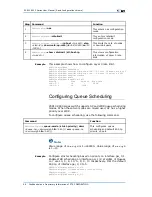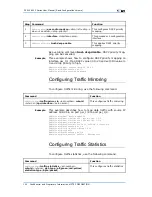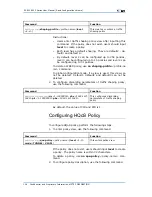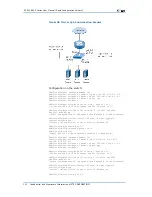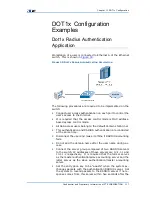
Chapter 10 QoS Configuration
Example
This example describes how to collect traffic statistics on data in
the network with destination IP address 67.100.88.0/24 on port
gei_4/8.
ZXR10(config)#acl extend number 100
ZXR10(config-ext-acl)#rule 1 permit ip 168.2.5.5 0.0.0.0 any
ZXR10(config-ext-acl)#rule 2 permit ip any 67.100.88.0 0.0.0.255
ZXR10(config-ext-acl)#exit
ZXR10(config)#traffic-statistics in 100 rule-id 2
ZXR10(config)#interface gei_4/8
ZXR10(config-if)#ip access-group 100 in
Configuring Queue-Based Bandwidth
Upper and Lower Threshold
Step Command
Functions
1
ZXR10(config)#
interface
<
interface-name
>
This accesses L2 configuration
interface.
2
ZXR10(config-if)#
traffic-shape
{
queue
<
queue-number
>{[
max-datarate-limit
<
rate
>]|[
min-gua-datarate
<
rate
>]}}
This configures queue-based
bandwidth upper and lower
threshold.
Configuring HQoS
Configuring Traffic Class
To configure traffic class, perform the following steps.
1. To create a traffic class or enter a traffic class, use the following
command.
Command
Function
ZXR10(config)#
flow-class
<
class-name
>
This creates a traffic class or
enters a traffic class
To delete a traffic class, use
no flow-class
<
class-name
>
command. If the traffic class is used, the class can not be
deleted.
2. To configure a matching rule, use the following command.
Command
Function
ZXR10(config-fclass)#
match
{
(acl
<
acl-no
>
rule
<
rule-no
>
)
|
tunnel
<
1-4096
>|
vlan
<
1-4094
>|
vip
<
1-16384
>}|
phb
{
be
|
af1
|
af2
|
af3
|
af4
|
ef
|
cs6
|
cs7
}}
This configures a matching rule
in traffic class configuration
mode
Confidential and Proprietary Information of ZTE CORPORATION
103










